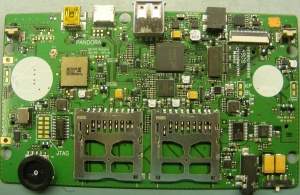Difference between revisions of "Hardware documentation"
From Pandora Wiki
(→Other OMAP3530 Projects: cat) |
(formating) |
||
| Line 1: | Line 1: | ||
| − | + | {{introNote|For adding custom extensions see [[Hardware hacking]]}} | |
| − | * Official Hackers Manual[http://www.openpandora.org/downloads/PANDORA_Hackers_manual_v100.pdf] from OpenPandora Ltd | + | |
| − | Posted on the official Blog, Saturday, 19 June 2010 18:24, includes warnings about damage and warranties (or loss of) | + | * Official Hackers Manual[http://www.openpandora.org/downloads/PANDORA_Hackers_manual_v100.pdf] from OpenPandora Ltd, Posted on the official Blog, Saturday, 19 June 2010 18:24, includes warnings about damage and warranties (or loss of) |
| + | |||
| + | ==Board== | ||
| + | [[image:Board_rev5.jpg|thumb|Pandora PCB rev 5]] | ||
| + | The Pandora is basing upon the [[Beagle Board]] layout. It bases upon a OMAP3530 System-on-a-chip, that includes a whole family of processors in one single chip: | ||
| + | *[[ARM]] Cortex-A8 CPU | ||
| + | *PowerVR SGX graphics core | ||
| + | *C64x+ DSP core | ||
==OMAP3530== | ==OMAP3530== | ||
| Line 7: | Line 14: | ||
*OMAP3530 specific page[http://focus.ti.com/docs/prod/folders/print/omap3530.html] ''This lists the features of the chip and has all the applicable Technical Documents'' | *OMAP3530 specific page[http://focus.ti.com/docs/prod/folders/print/omap3530.html] ''This lists the features of the chip and has all the applicable Technical Documents'' | ||
*OMAP35XX technical manual: [http://www.ti.com/litv/pdf/spruf98b] (38MB PDF) | *OMAP35XX technical manual: [http://www.ti.com/litv/pdf/spruf98b] (38MB PDF) | ||
| + | |||
| + | ==Other OMAP3530 Projects== | ||
| + | *Always Innovating Touch Book[http://www.alwaysinnovating.com/wiki/] | ||
| + | *Beagle Board Resources[http://beagleboard.org/resources] As it uses the same SoC, many BB resources are also relevant for the Pandora. | ||
| + | *Beagle Board Google Group[http://groups.google.com/group/beagleboard] | ||
| + | |||
| + | ==Cortex-A8== | ||
| + | This processor is part of the [[ARM]] risc cpu family[http://www.arm.com/products/processors/cortex-a/cortex-a8.php] that is licensed by a lot of hardware vendors. It has multiple command extensions as [[NEON]] (similar to MMX for x86 architecture) | ||
| + | *r1p1[http://infocenter.arm.com/help/topic/com.arm.doc.ddi0344b/DDI0344.pdf] ''Note: OMAP3530 uses rev1p2'' | ||
| + | *'''UPDATE''': r2p2 Documentation [http://infocenter.arm.com/help/index.jsp?topic=/com.arm.doc.ddi0344e/index.html] ''Note: OMAP3530 uses rev1p2'' | ||
| + | *NEON instruction set [http://infocenter.arm.com/help/index.jsp?topic=/com.arm.doc.dui0204h/Bcfjicfj.html] | ||
| + | *NEON memory hazards[http://hardwarebug.org/2008/12/31/arm-neon-memory-hazards/] | ||
| + | |||
| + | ==PowerVR== | ||
| + | *Official site[http://khronos.org/opengles/2_X/] | ||
| + | *[[OpenGL ES]] | ||
==C64x+== | ==C64x+== | ||
| + | Digital signal processors allow to do complex calculations within only a few cycles | ||
*CPU and Instruction Set Reference Guide[http://focus.ti.com/lit/ug/spru732h/spru732h.pdf] | *CPU and Instruction Set Reference Guide[http://focus.ti.com/lit/ug/spru732h/spru732h.pdf] | ||
*TMS320C6000 Assembly Language Tools v 6.0 Beta User's Guide[http://focus.ti.com/dsp/docs/dspsupporttechdocsc.tsp?sectionId=3&tabId=409&abstractName=spru186p] | *TMS320C6000 Assembly Language Tools v 6.0 Beta User's Guide[http://focus.ti.com/dsp/docs/dspsupporttechdocsc.tsp?sectionId=3&tabId=409&abstractName=spru186p] | ||
| Line 14: | Line 38: | ||
*TMS320C6000 Programmer's Guide[http://focus.ti.com/dsp/docs/dspsupporttechdocsc.tsp?sectionId=3&tabId=409&abstractName=spru198i] | *TMS320C6000 Programmer's Guide[http://focus.ti.com/dsp/docs/dspsupporttechdocsc.tsp?sectionId=3&tabId=409&abstractName=spru198i] | ||
| − | == | + | ==Display== |
| − | |||
| − | |||
| − | |||
| − | |||
| − | |||
| − | |||
*Screen datasheet (TD043MTEA2)[http://beyondinfinite.com/lcd/Library/Toppoly/TD043MTEA2.pdf] | *Screen datasheet (TD043MTEA2)[http://beyondinfinite.com/lcd/Library/Toppoly/TD043MTEA2.pdf] | ||
| − | |||
| − | |||
| − | |||
| − | |||
| − | |||
| − | |||
| − | |||
| − | |||
[[Category:Chipset]] | [[Category:Chipset]] | ||
Revision as of 19:10, 20 April 2011
For adding custom extensions see Hardware hacking
- Official Hackers Manual[1] from OpenPandora Ltd, Posted on the official Blog, Saturday, 19 June 2010 18:24, includes warnings about damage and warranties (or loss of)
Board
The Pandora is basing upon the Beagle Board layout. It bases upon a OMAP3530 System-on-a-chip, that includes a whole family of processors in one single chip:
- ARM Cortex-A8 CPU
- PowerVR SGX graphics core
- C64x+ DSP core
OMAP3530
- OMAP35x: Main page on TI site[2]
- OMAP3530 specific page[3] This lists the features of the chip and has all the applicable Technical Documents
- OMAP35XX technical manual: [4] (38MB PDF)
Other OMAP3530 Projects
- Always Innovating Touch Book[5]
- Beagle Board Resources[6] As it uses the same SoC, many BB resources are also relevant for the Pandora.
- Beagle Board Google Group[7]
Cortex-A8
This processor is part of the ARM risc cpu family[8] that is licensed by a lot of hardware vendors. It has multiple command extensions as NEON (similar to MMX for x86 architecture)
- r1p1[9] Note: OMAP3530 uses rev1p2
- UPDATE: r2p2 Documentation [10] Note: OMAP3530 uses rev1p2
- NEON instruction set [11]
- NEON memory hazards[12]
PowerVR
C64x+
Digital signal processors allow to do complex calculations within only a few cycles
- CPU and Instruction Set Reference Guide[14]
- TMS320C6000 Assembly Language Tools v 6.0 Beta User's Guide[15]
- TMS320C6000 Optimizing Compiler v 6.0 Beta User's Guide[16]
- TMS320C6000 Programmer's Guide[17]
Display
- Screen datasheet (TD043MTEA2)[18]
